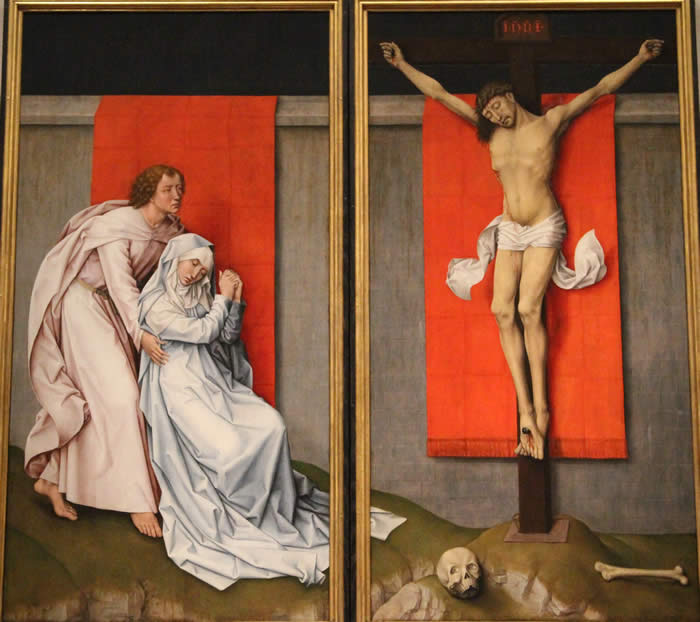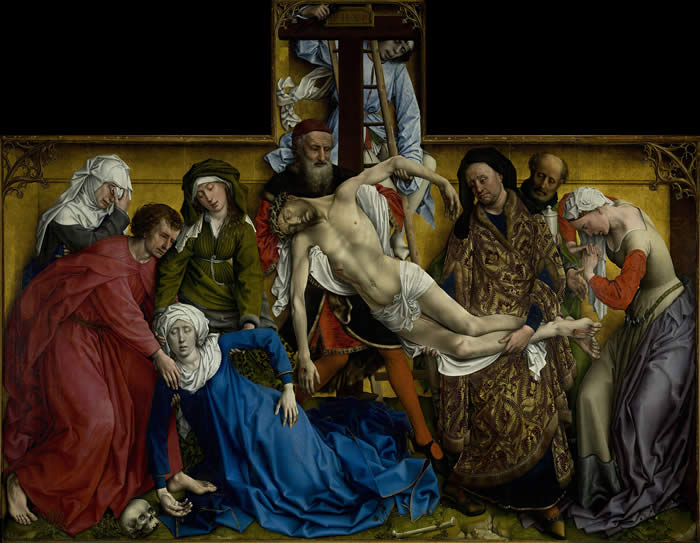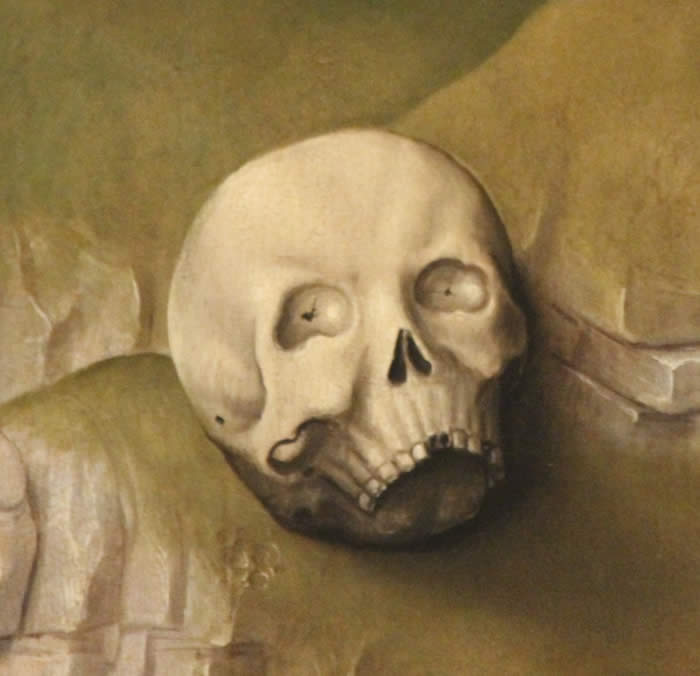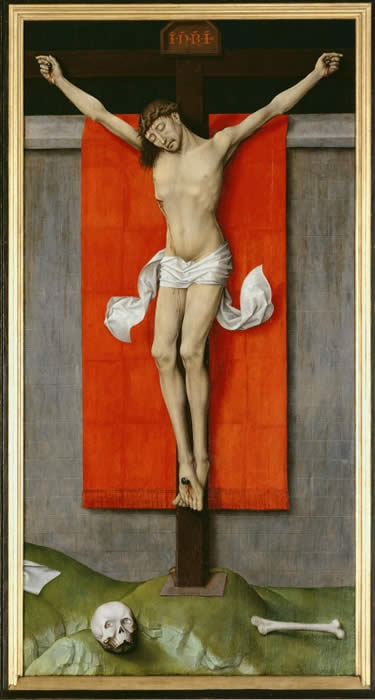The Crucifixion Diptych: A unique vision

Rogier van der Weyden, c. 1460
Oil on panel, 71 x 36 7/16"
I first encountered this painting in February 2012, at the Philadelphia Museum of Art. At first, registering it from a distance, I filed it in the back of my mind as just one more altarpiece from the Northern Renaissance. But the painting had an haunting presence and an insistent quality; it was somehow different than other paintings of its kind. In the hour or so that I circulated around the galleries, it grew on me more and more that this was a quite extraordinary work of art, unlike any of the many other pieces of the subject painted during that period.
Van der Weyden, widely considered to be one of the most influential Flemish painters of the Northern Renaissance, was a master of extremely fine and very detailed paintings, like his contemporaries Robert Campin and Jan van Eyck. His descent from the cross, now at the Prado Museum in Madrid, is far more typical of what one what expect of painters from this period, both in terms of contemporary style and popular demand.

Van der Weyden's exquisite sense of refinement and the crystalline precision of his renderings were special even when measured in terms of the Northern Renaissance, where such things were considered routine. But the crucifixion painting at the Philadelphia Museum displays a sublime refinement that projects an authority absent from very nearly any other paintings of its time — and, perhaps, of any time. Intriguingly, almost everything about the provenance of this painting is unknown. No one knows why it was painted. No one knows why it takes the form it does. One of the hypotheses is that it was done for devotional exercises in a monastic setting — believable, given its starkness.

The minimalism of the composition is apparent, even flagrant. The artist has removed every extraneous detail from this picture, so that we are focused on the passion of the cross with an unparalleled intensity and precision.
Most renaissance paintings invite a colorful pageant of emotion- but not this one. The composition establishes an uncharacteristic objective distance from the characters. Even the palette keeps its cool. Dressed in pale colors that understate their grief, yet keep them close to the anguished reality of Christ's death — which penetrates everything — the two figures in the left panel, St. John the Evangelist and the Virgin Mary, execute a perfect duet of stoicism and devotion against the right-hand panel of Christ's passion.

The two huge red banners, hung against the gray stone walls of Jerusalem, display a geometry and formalism that anticipates minimalist painting in a way that can't be found in any other work before the 20th century. The first conceptual seeds of Mark Rothko and Barnett Newman's paintings are planted here; the significant distances of subject matter, culture, and time that separate van der Weyden from 20th century artists evaporate when confronted with the consistency of aesthetic.
Although it's a surprise to encounter it here, the impulse to strip things down to the bare minimum and offer the viewer a fundamental, passionate experience of color alone is not a new one. There is Zen in this tradition; a willingness to engage in meditation created by the essence of the subject, the inner quality of the subject, the unseen qualities of the subject. Color becomes a sign for everything you cannot say; it is the poetic foil for the identifiable.
The less literal references, the more painting offers us a vehicle to discover the event — not on the canvas, where the event between the viewer and the artists never, ever takes place, but inside ourselves. And van der Weyden's crucifixion diptych certainly invites us to look inside ourselves; it commands an attention of a new kind. We receive this image in a place that is uncluttered; its impact is completely felt, because it has taken everything but the impact of the experience itself out of the composition. The image is extraordinarily powerful; yet its compelling power is derived from what has been taken away, rather than what is present. In the same way that modern minimalism attempts to deliver a visceral experience by paring away everything but the essence of the message, this painting has taken out anything that might distract from the essential point.

And that central point is, without a doubt, death. There is nothing else to contemplate here; anyone in the presence of this painting is left to contemplate mortality, nothing more. Any hint of resurrection has been expunged; only the cold fact of death remains, on the relentless crimson backdrop of the passion. The rest of the world is shut out by a gray wall; not only is nothing else happening, the very idea that anything else could happen has been excluded from this painting. It is a singularity, an isolated universe in which only the stark fact of Christ's death and passion can be considered. In the moment he captures, the artist suggests that the story has ended here — as though the resurrection itself, which we now all take for granted, is in doubt, may never take place. And this is, indeed, the emotional state those around Him experienced during the event, attesting to the concise psychological accuracy of van der Weyden's artistic vision.
What if it all ends here?, he seems to ask us; and he asks the questions not just with the imagery in the painting, but with its underlying form—its structure.

Even elements which would conventionally be exaggerated in order to inflame the passions have been minimized: the blood is almost unnoticeable, even graceful and delicate; the crown of thorns, though intimidating, is visually understated, and the wound in his side so tiny as to seem almost trivial. There is no sense of sensationalism in this painting; only a sense of the objective facts. We are not meant to contemplate anything more than what happened; and what happened, the artist seems to be suggesting, is enough. Embellishments are unnecessary.
The painting becomes, in the end, a meditation; a silent place one enters, a sacred place, and a private one, in which we are offered nothing more than what is absolutely necessary. All of the elements suggest the elements of a monastic practice; yet still, no comparatives exist to verify this idea. The painting stands alone.
Where did van der Weyden get the idea for this composition, so far removed from anything like it among his contemporaries? And what unique and unusual form of patronage would have funded a piece this extraordinary?
We won't ever know the answers to these questions. But the painting seems to be a reminder of what Beelezebub told his grandson:
"The sole means now of saving the beings of the planet Earth would be to implant in their presence a new organ, an organ like kundabuffer, but this time having such properties that every one of these unfortunates, during the process of his existence, should constantly sense and be aware of the inevitability of his own death, as well as of the death of everyone upon whom his eyes, or attention, rests.
"Only such a sensation and such an awareness could destroy the egoism so completely crystallized in them that has swallowed up the whole of their essence, and at the same time uproot that tendency to hate others which flows from it — the tendency that engenders those mutual relationships which are the chief cause of all their abnormalities, unbecoming to three brained beings and maleficent for them and for the whole of the universe." Beelzebub's tales to His Grandson, G. I. Gurdjieff, Triangle Editions 1992, p. 1083-84.
In the absence of such an organ implant, perhaps only symbolic objects can convey this meaning to us. And this painting— a cultural organ implant like the one Gurdjieff imagined at the end of his magnum opus—serves exactly such a purpose, whoever it was originally painted for.